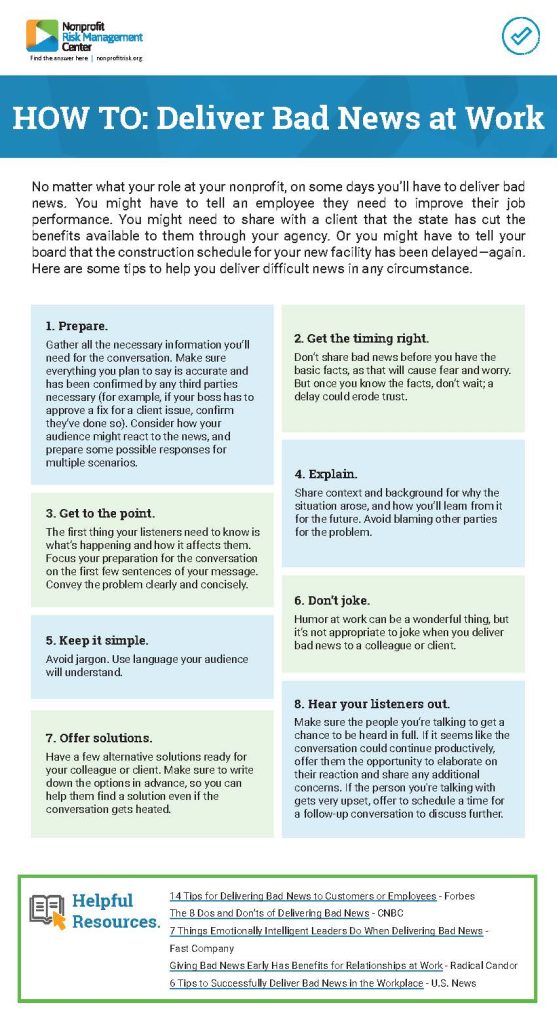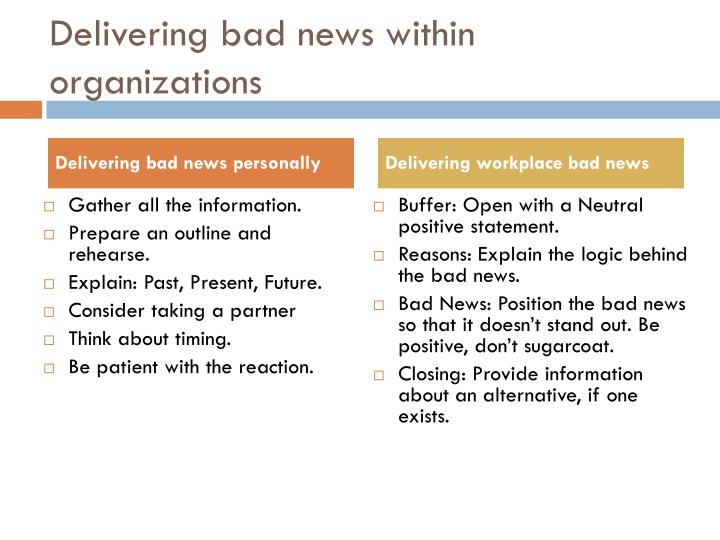How To Deliver Bad News In Business

Communicating unfavorable information effectively is paramount in maintaining trust and minimizing disruption. Mastering this skill can mitigate damage and preserve relationships during challenging times.
This article offers a concise guide to delivering bad news in a business setting, ensuring clarity, respect, and a focus on solutions.
Preparation is Key
Before breaking bad news, meticulously gather all relevant facts. Confirm the accuracy of the information to prevent miscommunication or the spread of misinformation.
Consider the impact on all stakeholders, including employees, clients, and investors. Understanding their perspectives is crucial for crafting a sensitive and appropriate message.
Prepare potential solutions or next steps to demonstrate proactive problem-solving. Showing a plan for moving forward can ease anxieties and maintain confidence.
Choosing the Right Medium and Timing
The gravity of the news dictates the delivery method. Face-to-face communication is often preferred for significant announcements to convey empathy and allow for immediate clarification.
However, circumstances like remote work or logistical constraints may necessitate video conferencing or a carefully worded phone call. Consider using Zoom, Teams or even a conference call.
Timing is also critical; avoid delivering bad news before holidays or during peak stress periods. Schedule the conversation for a time when recipients can process the information without undue pressure.
Delivering the Message with Clarity and Empathy
Begin by clearly stating the purpose of the conversation. Avoid ambiguity or beating around the bush, as this can create more anxiety. Be direct and truthful.
Use simple, straightforward language and avoid jargon. Ensure the message is easily understood by all recipients, regardless of their expertise.
Express empathy and acknowledge the impact of the news on the recipient. Use phrases like "I understand this is difficult to hear" or "I regret to inform you."
The Importance of Active Listening
Allow the recipient time to process the information and ask questions. Listen actively to their concerns and provide honest and thoughtful responses.
Avoid getting defensive or interrupting, even if the recipient expresses anger or frustration. Acknowledge their feelings and remain calm and professional.
Remember that active listening helps building bridges even in a tough situation.
Focusing on Solutions and Next Steps
After delivering the news and addressing concerns, shift the focus to solutions and next steps. This demonstrates a commitment to resolving the situation and moving forward.
Clearly outline the plan of action, including timelines and responsibilities. Provide resources and support to help recipients navigate the challenges ahead.
For instance, if announcing layoffs, provide information on severance packages, outplacement services, and unemployment benefits.
Documenting and Following Up
Document the conversation, including the date, attendees, and key points discussed. This provides a record of the communication and helps prevent misunderstandings later on.
Follow up with recipients to address any remaining questions or concerns. Offer ongoing support and resources to help them cope with the situation.
Regular communication and transparency are essential for rebuilding trust and maintaining positive relationships. Consider sending a summary email to confirm the agreement.
Legal and Ethical Considerations
Ensure all communications comply with relevant labor laws and regulations. Consult with legal counsel to review sensitive announcements, especially those involving terminations or layoffs.
Maintain confidentiality and avoid disclosing private information to unauthorized parties. Respect the privacy and dignity of all individuals involved. Be mindful of compliance rules.
Delivering bad news with integrity is crucial for maintaining a positive reputation and fostering a culture of trust and respect. Honesty is the best policy.
Conclusion: Moving Forward with Transparency
Delivering bad news is never easy, but by following these guidelines, you can minimize the negative impact and preserve valuable relationships. Remember, honest and proactive communication builds resilience.
Ongoing developments will be communicated as they arise, with a commitment to transparency and open dialogue. The most important thing is to keep the communications channel open.


















